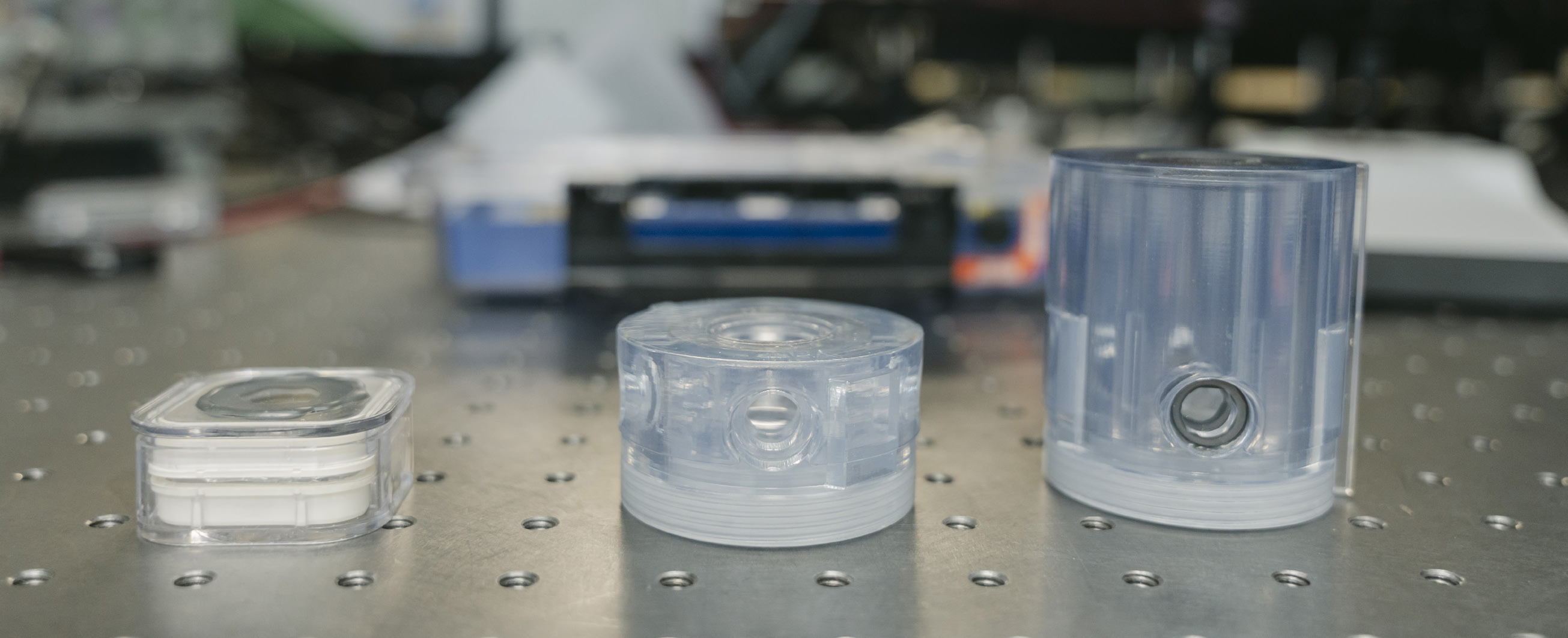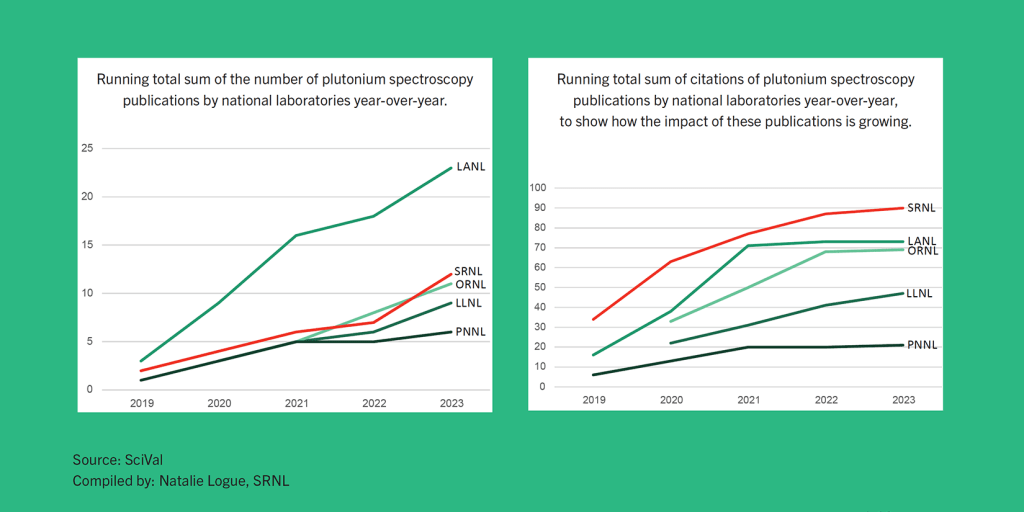“It [the Double-Walled Cell] makes the job possible in the first place.” – Don Dick

New versions of the Double-Walled Cell. Photo by LJ Gay, SRNS.
Spectroscopy is a scientific process used to identify the characteristics of nuclear material when light interacts with the sample. The Laser Spectroscopy Team within Savannah River National Laboratory’s (SRNL) Global Security Directorate (GSD) support vital nonproliferation efforts by analyzing a sample to reveal critical information such as the production conditions inside a reactor, material purification processes, and enrichment quantification, which can answer the “when, how, and where” of radioactive material creation. These signatures help identify the methods of material generation. The team has attained a multitude of scientific achievements in this field in the last three years. These successes can be tied directly to two events: the development of the Double-Walled Cell and the COVID-19 pandemic.
Most spectroscopy researchers use a container to hold the nuclear materials and employ equipment in a contained radiological lab for analysis. A Double-Walled Cell uses this concept but changes the container to fit different equipment and the testing environment by meeting certain safety requirements. Chief among these conditions is to contain the nuclear material during analysis, not impede the measurement, transport the material outside of radiological buffer areas, and complete the analysis outside a fixed and tight container called a glovebox.
Eliel Villa-Aleman and his team perform their experiments inside a clean laboratory in the 735-A Building at SRNL. The team of three takes microscopic nuclear materials housed inside a Double-Walled Cell and places them in various instruments that conduct Raman, fluorescence, infrared, and other types of spectroscopy tests. Villa-Aleman says the goal is simple, “To detect one or more signature(s) to understand any nuclear material.”
Villa-Aleman and his team felt the move to the Double-Walled Cell was necessary to grow its research capabilities and move from a glovebox environment to a clean laboratory. The extra space inside a clean lab allows the team to add new equipment and “develop signatures of the material that wasn’t possible,” stated Villa-Aleman. Don Dick, a Scientist 2 on the team, described the difference between the two settings saying, “It would be much more difficult to align everything together in a glovebox environment than it is here [clean laboratory].”

Double-Walled Cell prototype used for Raman and diffuse reflectance spectroscopy. Photo by LJ Gay, SRNS.
A glovebox worker takes the clean cell, with sticky tape inside it, and places one or more microscopic nuclear sample(s) in it. One glovebox materials handler holds the cell with one hand while another places the second outside cell on top and screws it in place. The completed cell now safely holding the radioactive materials, it’s checked for nuclear material on the outside of the cell and then, if clean, brought to the clean lab.
The rapid rise of spectroscopic capabilities began at SRNL in 2015 when Villa-Aleman designed the original Double-Walled Cell. Between 2015 and 2020, the team used the original version to conduct several new experiments. But the team wanted to run more and different tests, which mean new and different Double-Walled Cells.
Then COVID-19 happened, and the spectroscopy group’s operational tempo slowed.
The change of pace afforded Villa-Aleman, Don Dick, and engineer Mike Maxwell more time to think of ways to improve the original Double-Walled Cell design. Villa-Aleman recognized the need, “We knew there was a much better future than what we were doing.” Understanding the flaws of the original model, the team quickly developed new versions.

Double-Walled cell in use during a Raman spectroscopy experiment which contains a sample of 239PuO2. Photo by LJ Gay, SRNS.

The pace of SRNL’s plutonium spectroscopy publications as well as the number of citations those articles receive have increased noticeably in the last few years thanks to the Double-Walled Cell innovation.
Villa-Aleman created a list of new, necessary features. Dick drew up the blueprints in a computer-aided design (CAD) program and passed the blueprints to Maxwell, who refined the blueprints and fabricated the prototypes using additive manufacturing. The team also collaborated with the radiological materials team to ensure the designs were usable within a glovebox environment and prevented the sample from exposure. Dick pointed out the need for teamwork saying, “It’s not a very dexterous environment using a glovebox.”
Two months of development between the spectroscopy group, Maxwell, and the radiological materials team resulted in the second iteration of the Double-Walled Cell.
The SRNL Spectroscopy group now uses seven different types of Double-Walled Cells to complete different types of spectroscopy tests. They are set to obtain a patent for their Double-Walled Cell design in early 2024.
Equipment and space availability is not the only benefit of using the Double-Walled Cell. Two of its most vital qualities are time and safety.
Dick described the difference between the old and current testing processes as, “Spectroscopy testing in a glovebox can easily take us more than a week to complete versus what we do in a clean laboratory in a day.” He added, “It [the Double-Walled Cell] makes the job possible in the first place.”

Don Dick positioning the Double-Walled Cell for use in a Raman experiment. Photo by LJ Gay, SRNS.
The group published nine papers and were cited 61 times in the last four years thanks to the Double-Walled Cell. The team’s publication rate is higher than any other national laboratory in the plutonium spectroscopy research area. Villa-Aleman says he’s spending more time authoring reports and analyzing test results than performing the examinations.
On the safety side, the Spectroscopy Group maintains SRNL’s guidelines by miniaturizing glovebox requirements into a handheld object. The quartz or Barium fluoride (BaF2) window and hard plastic cells allows the team to store a limited number of materials in the clean lab, where they can recall the materials and perform additional tests to evaluate how the material(s) change over time.
Other national laboratories have noticed the effectiveness and application of SRNL’s Double-Walled Cell. Oak Ridge National Laboratory contacted the SRNL team to assist its development of a Double-Walled Cell.
Villa-Aleman says he won’t stop expanding the testing potential. His next step is to test materials in cryogenic conditions.
Each advancement in Double-Walled Cell technology builds a better tool for nonproliferation efforts with the goal of taking a sample of radioactive material(s) and accurately figuring out its origin and intended purpose, thus stopping bad actors from obtaining dangerous weapons.

IR spectra of Pu2(C2O4)3•9(H2O) (Pu-25) and its thermal degradation products. This data, obtained using a Double-Walled Cell containing plutonium (III) oxalate, was published in the October 2023 issue of Journal of Nuclear Materials.